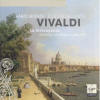Texte paru dans: / Appeared in:
*

GRAMOPHONE (07/2011)
Pour s'abonner /
Subscription information
Virgin Classics
5193002

Code-barres / Barcode:
5099951930028 (ID153)
Consultez toutes les évaluations recensées pour ce cd
~~~~ Reach all the evaluations located for this CD
Reviewer: Iain Fenlon
Exploring Venetian music tailored to London tastes
Fresh from their success with Vivaldi’s opera Ercole su’l Termodonte,
reconstructed by director Fabio Biondi (3/11), Europa Galante continue their
powerful advocacy of some of the lesser-known corners of Vivaldi’s enormous
output. This latest recording presents six concertos for solo violin (sometimes
a second soloist is called for), strings and basso continuo from the collection
La stravaganza. Originally written in 1712-13 and first published in the
following year, they were reissued by London’s leading music publisher, John
Walsh, in 1728.
Vivaldi’s music greatly appealed to English taste – milords bought copies on the Grand Tour and the music rooms of country houses were full of it. It is easy to see why. The 12 concertos that make up La stravaganza may not be as well known as The Four Seasons but they display remarkable compositional inventiveness within what is a limited three-movement template.
Fabio Biondi’s
playing is characterised by impressive variety, from the crisp articulation of
the outer fast movements to the mellow-toned warmth of the slow ones. The
unexpected harmonic twists are savoured to the full (listen to the Larghetto of
the F major concerto for a particularly plangent instance), and a discrete
amount of improvised ornamentation has been sensitively added. While there is
plenty of swooping virtuosity on display, in the end it is the slow movements
which impress with their consistently haunting quality. Europa Galante provide
fine support with a full string sound, suffused with a shimmering halo of
harpsichord figuration. Certainly not all these movements are equally inspired
but careful selection rather than end-to-end listening in a single sitting is
the way forward.
I N T E R V I E W
Fabio Biondi Stylistically speaking, in some ways the last decade has been very exciting while in others it’s been a little confusing. A lot of new ensembles have arrived and sometimes there is a dangerous pattern in Italy where we want to play faster, play a little more actively and so on. It’s typical of our culture and it comes from the language. But you have to think intelligently and try not to exaggerate; for me, you can’t repeat the same musical patterns or formulas without a deep re lection of what the composer is trying to say and what kind of music it is. It’s a great opportunity to think about every tonality, every movement and every sound – the difference between every piece.
Playing standards are very high these days but it’s important not to say, for example, that Vivaldi is best played by Venetian or Italian performers.
There are many different ways of viewing Vivaldi and I much admire the English approach. In some ways music is geography: in Vivaldi’s time these pieces were exported to every part of Europe, so we can never forget there were many ways of playing them.
Walsh’s edition
of La stravaganza is interesting [Walsh took five of Vivaldi’s 12 Stravaganza
concertos and a concerto in F]. Six concertos are better than 12 – six is a good
length for the audience – and it was successful because it’s very concentrated,
good quality, with some outrageous elements. The last concerto in F is a little
mystery: I’m not completely sure that it’s all by Vivaldi. I think probably
Walsh or another musician collected together different movements to create this
concerto, and its style is completely different.
Interview by Andrew
Mellor
Cliquez l'un ou l'autre
bouton pour découvrir bien d'autres critiques de CD
Click either button for many other reviews


